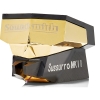Transformer use with Soundsmith MI/Fixed coil designs
Transformer use with Soundsmith High, Medium and Low output MI/Fixed coil designs
Soundsmith High output designs (like ANY high output design) must NEVER be used with step-up transformers. They are designed to be used with standard MM phono preamps – 47K Ohms load, with 100-300 pf capacitance loading - to taste. The pf loading will affect the mid and top end sound/roll characteristics. Preferred gain range is 40-44 db. Our MMP3 and MMP4 preamps are perfect for our High Output designs.
Our low output (and medium output) designs can be used (and often are used) with step ups, as follows.
Our low output carts need a 470 Ohm MINIMUM load, reflected through a step up or direct load. Higher value Ohm loads will rise the top end a bit. (BTW – this is why our MCP-2 phono preamp is designed with VARIABLE loading on the fly – not limited, fixed values that often require opening up the preamp and modifying the load with various levels of challenge therein). The MCP-2 allows tuning to any low output cartridge by "ear".
The Soundsmith Hyperion, Sussurro, Paua and new Zephyr MIMC Star can be used perfectly with a step up. A typical step up for an MC cartridge is one with a 1:10 ratio or 20dB of gain. This takes our above four low output MI cartridges which have a typical MC level (.3 ~ .4mV) and brings the voltage up to 3 ~ 4mV, so a 1:10 ratio is a perfect transformer fit to use with our low output MI cartridges into an MM preamp (see below for the math to explain why).
Loading is critical for any and all low output cartridges in determining their top end response – and our low output designs are no exception. Ours however, require a load of 470 Ohms minimum.
However, it is important to keep in mind that the characteristics of SOME transformer windings can be too low to use with our designs. Obviously, there are many ways to make a 1:10 step up. If the inductance (not usually supplied ! ) of the windings are too low, the load on the cartridge can limit listening level or performance. Our step-up transformers we make for our MCP-2 preamps (which can be used with all our low output designs) are very flexible - they have specifications that will work with any LOW OUTPUT DESIGN. The MCP-2 also gives the user the ability to TAILOR the reflected load to any low output designed cartridge over a wide range. If you are using your own step up, please see below how to calculate the load for any low output cartridge.
When using a transformer, one always calculates loading as follows. One takes the denominator of the ratio of the transformer, squares that, and divide it into the resistive LOAD that is used on the secondary of the step-up transformer (this is the load across the output of the transformer – OR what the transformer output “sees” or feeds “into”).
A typical example of a reflected load would be, if one had a 1:10 transformer, and used it into a MM input load (almost always 47,000 Ohms), one would get 47,000 divided by (10 x 10) = 100, resulting in a 470 Ohm “effective” load. Simple.
If one had a 1:5 transformer, it would be 47,000 divided by 25 which equals a 1880 Ohm load. A ratio of 1:12 would be 47000 divided by 144 or 326 Ohms.
Our MEDIUM output cartridges are designed for a minimum load of 1500 Ohms and are targeted for preamps that have fixed gain of 48-52 dB, and/or ones that try to AVOID the use of step ups, for philosophical reasons. These include historically Conrad Johnson, Audio Research, many DIY designs and others. You CAN use a 1:5 step-up into an MM input, which we make and sell directly. Our Medium output desgins are 1.1 mV output.
The thought from preamp designers that do NOT use step-ups is to allow MEDIUM output designs to avoid a step-up, as they require 48-52 dB. of gain which is fairly easy to do without a tep-up and without too much circuit noise.
If one WERE to need to use an MM preamp with our Medium output designs, your CAN use a step-up following the same formula shown above. For example, a 1:5 step up (10 dB. of gain) would mean 47,000 divided by 25 (5 x 5), or an 1880 Ohm reflected load.
An MM load of 47K will work with our medum output designs, so you can get away WITHOUT using a step up, ONLY assuming the MM preamp has variable gain and can be switched to a proper gain level of 48-52 dB. Most MM preamps usually have 38-42 dB of gain, and most are not gain or load switchable, BUT an external load can be easily used !
Our FIVE medium output designs were bought to life to fill a large hole in the market – there are very few cartridges like them available now (in contrast to years before, when Benz and others made them).
We did this specifically to address the needs of customers who have Conrad Johnson, ARC, as well as other designs that have fixed medium gain (and tried to avoid the use of step-ups) and therefore can ONLY be used with medium level output cartridges.
We have received many complaints over the years of ARC owners using HIGH output cart designs, and resulting in distortions (overload) on peaks that they think is due to cartridge mistracking. It is not.
Low output cart designs will “work”, with such preamps, but will NOT match the level of their other input sources, often resulting in speaker damage when they switch from Phono to any line input and have forgotten to turn the volume way down beforehand.
Peter Ledermann / President / Chief Engineer









